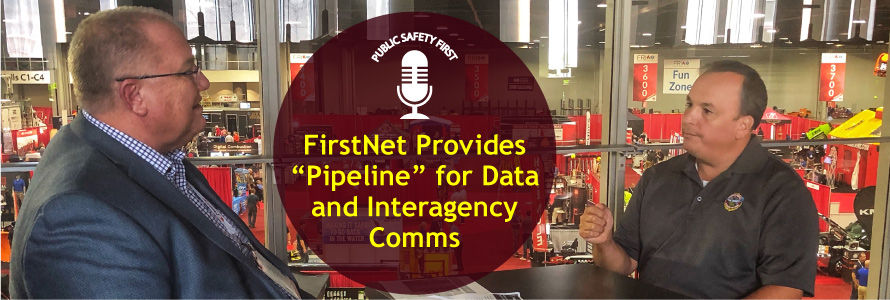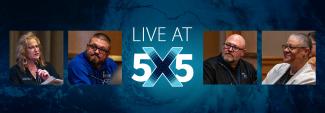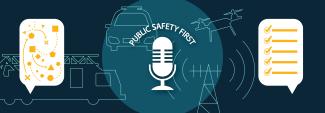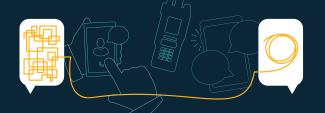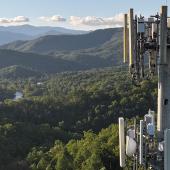Summary
FirstNet Authority Senior Public Safety Advisor Gary McCarraher sits down with Chief Charles Doody to discuss the Canton (MA) Fire Department’s migration to FirstNet and how the network provides a pipeline for data and helps fill communications gaps that traditional portable radios cannot.
Guest
Gary McCarraher
FirstNet Authority Senior Public Safety Advisor
Chief Charles Doody
Canton Fire Department, Massachusetts
Transcript
Preview
Narrator: You're listening to Public Safety First, a podcast to help you learn about the First Responder Network Authority and how you can be part of the future of public safety technology.
And now, your host.
Gary McCarraher: Good afternoon, we’re here at FRI [Fire Rescue International] in Atlanta with Chief Charlie Doody of the Canton (Massachusetts) Fire Department. Chief, thank you for your time this afternoon in talking to us. Can you just introduce yourself and tell us a little bit about your organization?
Chief Charles Doody: Sure, sure. I am the fire chief in the town of Canton, Massachusetts. We’re a 54-member career organization. We provide the typical range of services: fire suppression, EMS [emergency medical services], hazardous materials, all that fun stuff, so.
Narrator: You're listening to Public Safety First, a podcast to help you learn about the First Responder Network Authority and how you can be part of the future of public safety technology.
And now, your host.
Gary McCarraher: Good afternoon, we’re here at FRI [Fire Rescue International] in Atlanta with Chief Charlie Doody of the Canton (Massachusetts) Fire Department. Chief, thank you for your time this afternoon in talking to us. Can you just introduce yourself and tell us a little bit about your organization?
Chief Charles Doody: Sure, sure. I am the fire chief in the town of Canton, Massachusetts. We’re a 54-member career organization. We provide the typical range of services: fire suppression, EMS [emergency medical services], hazardous materials, all that fun stuff, so.
Gary McCarraher: Good deal. So, we’re here today to talk about your experience with FirstNet. What are some of the biggest communication challenges you think your firefighters face today?
Chief Charles Doody: There are several challenges, I think, communications-wise that they face. Our biggest issue, I would say, from a small town’s perspective is simply the ability to transmit over portable radios. Now, there are areas in our community that because of demographics, the signal quality is poor, and oftentimes communications can be impacted by that. Fortunately, they haven’t been impacted in a serious way. There’s never been anybody that’s been in a fire that hasn’t been able to transmit out, but it’s certainly a potential if we don’t correct those issues.
Gary McCarraher: So, I know you’re recent, recently migrated to the FirstNet –
Chief Charles Doody: We did.
Gary McCarraher: – network, and what do you think mobile broadband will enable you to do that you can’t do presently?
Chief Charles Doody: Well, I mean, I think the thing that attracted us to the FirstNet initially was the preemption part of the program. Having the ability to make cell phone calls when a type of large event is happening, and being able to actually make a connection was attractive to us. But, the other thing that is interesting is the, I think you described it as a pipeline for first responders, and, you know, looking a little bit towards the future, having the ability to access data on laptop computers and quickly get information you need for planning purposes, response purposes was something that made us think about FirstNet, as well.
Gary McCarraher: I know in your migration to FirstNet, you’re looking at the radio over IP –
Chief Charles Doody: Yes.
Gary McCarraher: – feature. How do you envision using that – initially, and then long-term in the organization?
Chief Charles Doody: It’s interesting. You asked earlier about the challenges that firefighters have communications-wise. So, one of the things that was also attractive about the FirstNet was the LMR [land mobile radio] functionality, the land mobile radio functionality. So, we saw that initially as an opportunity to, kind of, fill in those gaps where the traditional portable radio will not work, and we’ve done some beta testing of it in large structures, for example, that we can’t get radio communications in and out of, yet. They’ve been retrofitted with antennas for cell phone usage. So, it was amazing they could be in a building and pull up their LMR and be able to communicate clearly right back to fire alarm, where they can’t do that with a portable radio. So, initially, that’s going to fill that gap for us.
Gary McCarraher: With no real investment by your organization, right?
Chief Charles Doody: Minimal. Minimal investment, yeah.
Gary McCarraher: Do you have any tips for any other agencies that may be looking at the migration that would make it easier for them?
Chief Charles Doody: I think you want – if you want to migrate, there’s opportunity with FirstNet for multiple agencies or departments to be part of it. So, rather than look at it from just a fire department perspective, I think it would be helpful if you pulled in, for example, the police chief, and even the DPW [Department of Public Works] superintendent, because there are, you know, ways that FirstNet can be set up to include DPW personnel if you have –
Gary McCarraher: Sure.
Chief Charles Doody: – an emergency of some, of some type that you needed them. So, I would say try to put together kind of like a coalition of leaders in your community, and sit down and talk about what the value of FirstNet could be for each of your departments.
Gary McCarraher: So, where do you envision long-term public safety communications going, say, in the next decade or so?
Chief Charles Doody: Compared from when I started, we really are becoming dependent on the ability to access data. So, I see it as more than radio communications, mobiles, and portables. I see it as the ability to utilize tablets, laptops, whatever device you need to access the internet or the FirstNet pipeline. I think that that is an emerging technology that we need to look at. You know, right now we can sign on to a call, we can sign off on scene to a call, we can clear a call without ever getting on the radio. We can do it via laptop. So, I think that the ability to do that quickly, efficiently, and then have it be reliable is something that we’ll be looking at a lot.
Gary McCarraher: Have you seen any emerging technologies that you think would be interesting for implementation back at your agency?
Chief Charles Doody: Yes. The thing that’s interesting to me is the potential integration of radio communications into things like SCBAs [self-contained breathing apparatuses].
Gary McCarraher: Okay.
Chief Charles Doody: You know, having the ability to, you know, Bluetooth in your communications to a firefight- inside a firefighter’s mask without the need to use a portable radio, I think, is interesting, and I don’t know, in some respects I think, maybe, FirstNet might be a part of that down the road.
Gary McCarraher: Yeah, so just piping that information –
Chief Charles Doody: Yeah.
Gary McCarraher: – back out to folks?
Chief Charles Doody: Yeah.
Gary McCarraher: One of the things that’s important to FirstNet moving forward is how we invest in the user experience, and by that we mean form function and things like that. Is there anything off the top of your head that you can think of – heads-up displays – that we really should be focusing our energies towards?
Chief Charles Doody: It seems to me that there’s a potential for FirstNet devices to actually, in some instances, replace portable radios. So, what are those opportunities that you could utilize a FirstNet device that you, right now, are traditionally using a portable radio for? Can you make them rugged enough, or intrinsically safe enough, like a portable radio is now, to replace that piece of equipment? And I don’t know what the answer is to that. And, if you were able to do that, then what could you add to that device in addition to voice? Can you get data to a place, to a heads-up display, for example –
Gary McCarraher: Gotcha, yep.
Chief Charles Doody: – from that device?
Gary McCarraher: It’s been a real pleasure speaking with you today, Chief. Thanks for joining us.
Narrator: Thanks for listening today. We're excited to have you join our podcast community. Make sure to subscribe on iTunes, SoundCloud, and YouTube. You can learn more about the First Responder Network Authority at FirstNet.gov and learn about FirstNet products and services at FirstNet.com.


